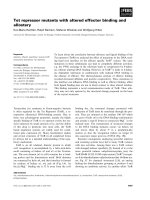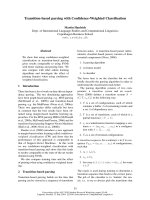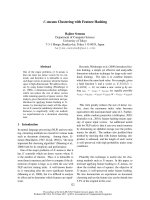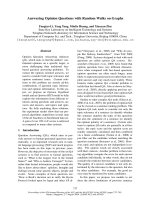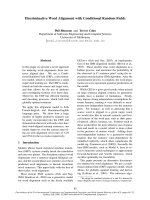Báo cáo khoa học: "Supracricoid partial laryngectomy with cricohyoidoepiglottopexy in patients with radiation therapy failure" ppsx
Bạn đang xem bản rút gọn của tài liệu. Xem và tải ngay bản đầy đủ của tài liệu tại đây (413.62 KB, 5 trang )
BioMed Central
Page 1 of 5
(page number not for citation purposes)
World Journal of Surgical Oncology
Open Access
Research
Supracricoid partial laryngectomy with cricohyoidoepiglottopexy in
patients with radiation therapy failure
Kuauhyama Luna-Ortiz*
1,2
, Philippe Pasche
3
, Mario Tamez-Velarde
1
and
Veronica Villavicencio-Valencia
1
Address:
1
Department of Head and Neck Surgery, Instituto Nacional de Cancerología (Mexico), Av. San Fernando #22, Tlalpan, Mexico, D.F.,
14080, Mexico,
2
Universidad Nacional Autonoma de México (UNAM), Mexico, D.F., Mexico and
3
Service dÒRL, Centre Hospitalier Universitaire
Vaudios, Lausanne, Switzerland
Email: Kuauhyama Luna-Ortiz* - ; Philippe Pasche - ; Mario Tamez-
Velarde - ; Veronica Villavicencio-Valencia -
* Corresponding author
Abstract
Background: To assess functional results, complications, and success of larynx preservation in
patients with recurrent squamous cell carcinoma after radiotherapy.
Methods: From a database of 40 patients who underwent supracricoid partial laryngectomy
(SCPL) with cricohyoidoepiglottopexy (CHEP) from June 2001 to April 2006, eight patients were
treated previously with radiotherapy due to squamous cell carcinoma of the glottic region and were
treated for recurrence at the site of the primary cancer.
Results: SCPL with CHEP was performed in six men and two women with a mean age of 67 years
due to recurrence and/or persistence at a mean time of 30 months postradiotherapy (in case #8
after concomitant chemoradiotherapy). Bilateral neck dissection at levels II-V was performed in six
patients. Only case #8 presented metastasis in one node. In case #5, Delphian node was positive.
It was possible to preserve both arytenoids in five cases. Definitive surgical margins were negative.
Complications were encountered in seven patients. Follow-up was on average 44 months (range:
20-67 months). Organ preservation in this series was 75%, and local control was 87%. Overall 5-
year survival was 50%.
Conclusions: In selected patient with persistence and/or recurrence after radiotherapy due to
cancer of the larynx, SCPL with CHEP seems to be feasible with acceptable local control and
toxicity. Complications may occur as in previously non-irradiated patients. These complications
must be treated conservatively to avoid altering laryngeal function.
Introduction
Primary radiotherapy as treatment for early cancer of the
glottis has been the most used treatment modality due to
its low morbidity and excellent prognosis [1,2]. Rate of
recurrence is reported to be from 13 to 36% [3-6]. In Mex-
ico, this type of treatment is not an exception because it
constitutes the main treatment modality in most oncolog-
ical centers. However, according to a review of the litera-
ture there is only one series published in our country by
Rodríguez Cuevas et al. [7], which demonstrates recur-
rence but does not accurately reflect the recurrence of glot-
tic carcinoma after radiotherapy in Mexican patients.
Published: 19 December 2009
World Journal of Surgical Oncology 2009, 7:101 doi:10.1186/1477-7819-7-101
Received: 27 April 2009
Accepted: 19 December 2009
This article is available from: />© 2009 Luna-Ortiz et al; licensee BioMed Central Ltd.
This is an Open Access article distributed under the terms of the Creative Commons Attribution License ( />),
which permits unrestricted use, distribution, and reproduction in any medium, provided the original work is properly cited.
World Journal of Surgical Oncology 2009, 7:101 />Page 2 of 5
(page number not for citation purposes)
Total laryngectomy continues to be the most frequently
used procedure with postradiotherapy recurrence. Several
attempts have been made at organ preservation such as
the use of laser endoscopic procedures [8,9] or converting
vertical hemilaryngectomies [10] to supracricoid larynge-
ctomies [7,11]. The present study was designed to assess
functional results, complications, and success in preserv-
ing the larynx in patients with recurrent postradiotherapy
squamous cell carcinoma.
Materials and methods
From a database of 40 patients who underwent supracri-
coid partial laryngectomy (SCPL) with cricohyoidoepi-
glottopexy (CHEP) from June 2001 to September 2008,
eight patients had previously been treated with radiother-
apy due to squamous cell carcinoma of the glottic region
and sought treatment due to recurrence at the primary
site, which would comply with the classic criteria
described by Laccourreye et al. [12] for this surgery as fol-
lows: when there is less mobility of the arytenoids and
subglottic invasion ≤ .5 cm to the posterior commissure.
All patients were staged at recurrence. Patients had chest
X-rays, computerized tomography of the larynx and neck,
nasofibrolaryngoscopy (with biopsy when possible), and
suspension microlaryngoscopy to confirm recurrence
when nasofibrolaryngoscopy results were inconclusive. In
six cases, a bilateral neck dissection at levels II-V was per-
formed, the Delphian node was intentionally searched
for, and surgical margins were intra-operatively assessed.
Hospital stay was assessed in days, along with the perma-
nence of the tracheostomy and the nasogastric feeding
tube for postoperative evolution, but not quality of voice.
Demographic data were analyzed using statistical package
SPSS for Windows (v.15). Kaplan-Meier method was used
to calculate overall survival.
Results
SCPL with CHEP was performed in six men and two
women (mean age: 67 years, median 65 years) due to
recurrence and/or persistence of laryngeal cancer (mean
time 30 months, median 12 months, postradiotherapy).
In case #8, concomitant chemoradiotherapy was used.
However, radiotherapy doses were only able to be accu-
rately established in four cases because the remaining
cases were referred from other institutions. Bilateral neck
dissection at levels II-V was performed in six patients.
Only case #8 presented metastasis in one node and case
#5 was positive for Delphian node. In five cases it was pos-
sible to preserve both arytenoids. Surgical margins were
intra-operatively assessed in all cases and, when these
were close to being positive, in some cases the margin was
widened to include one arytenoid. Definitive surgical
margins were negative (Table 1).
Table 2 shows postoperative evolution and complica-
tions. Complications occurred in seven patients, four with
edema of the arytenoids. In case #3, in whom this
occurred, resection of the mucosa of the arytenoids was
performed, leading to their fixation that induced ankylo-
sis of the arytenoids. Hence, the patient was confined to
gastrostomy for 2 years due to chronic aspiration and
underwent phoniatric rehabilitation. At 4 1/2 years after
treatment, the patient is currently without gastrostomy.
Based on this event, subsequent patients with the same
complication have been treated only with steroids, lead-
ing to better results. Another complication was infection
of the tracheostomy in two patients who were treated only
with antibiotics. The most severe complication was rup-
ture of the pexy in case #5 on postoperative day 15, neces-
sitating total laryngectomy.
Initial TNM classification, as well as that of postradiother-
apy recurrence, depicts migration of the stages at the time
of recurrence (Table 3). Currently, four patients are alive
and disease free, two are alive with pulmonary metastatic
disease, and two patients were lost, being disease free with
an average follow-up of 44 months, median 45 months
(range: 2-81 months). Preservation of the larynx in this
series was accomplished in 6/8 patients (75%), and local
Table 1: Demographic data and status
Case # Age Gender RT (Gy) Recurrence,
persistence or
relapse (months)
Neck dissection Delphian node Preserved
arytenoids
Status/follow-up
(months)
1 56 M 76 11 Bilateral Negative 2 AwoD (57)
2 43 M ? 144 Bilateral Negative 2 AwoD (54)
3 70 M 70 36 Bilateral Negative 2 AwoD (55)
4 65 M ? 5 No Negative 2 AwoD (54)
5 87 F ? 12 No Positive 1 AwoD (45)
6 77 M ? 14 Bilateral Negative 2 LwoD (1)
7 80 F 66 12 Bilateral Negative 1 LwoD (1)
8 61 M 70 4 Bilateral Negative 1 AwD (9)
AwoD, Alive without disease; LwoD, Lost without disease; AwD, Alive with disease; RT, radiation therapy.
World Journal of Surgical Oncology 2009, 7:101 />Page 3 of 5
(page number not for citation purposes)
control was obtained in 7/8 patients (87%) (Table 4).
Overall 5-year survival was 50% (Figure 1).
Discussion
Radiotherapy continues to be the most frequently used
treatment for glottic carcinoma of the larynx in many
oncological centers; however, at our institution we have
recently instituted changes to this approach by more often
offering surgical treatment for lesions in their early stages
[13]. In this study, one of the most interesting aspects was
the assessment of postradiotherapy recurrences. Total
laryngectomy continues to be the most used procedure for
this. This is mainly due to the lack of experience in the
techniques of conservative surgery of the larynx as well as
to the notion of a marked increase of complications that
some surgical groups have associated with partial larynge-
ctomies. Surgical salvage treatment with SCPL is possible
in selected patients who seek medical care, presenting a
similar clinical status to the initial condition and/or with
progression but complying with the classical criteria
established for this surgery. These are currently less limit-
ing than their original description by Laccourreye et al.
[12]. In this regard, a report of the main European group
on 12 patients [11] has prompted the use of the SCPL
approach for postradiotherapy recurrences in Mexico.
Only one group in Mexico has published cases on partial
laryngectomies in previously irradiated patients [7],
although they include only two cases with SCPL but with
cricohyoidopexy. Recently, results have been published
from other series [14-16] with the same purpose using
SCPL with CHEP.
Mean age of patients in our series was 67 years, similar to
that reported by Laccourreye et al. [11]. Mean follow-up
time after completion of radiotherapy was 30 months,
although one patient was radiated 14 years prior. Mean
Table 2: Postoperative success and complications of SCPL with CHEP in post-radiotherapy recurrences.
Reference
(no. of cases)
Mean
decannulation
(range) days
Mean
deglution
(range) days
Mean
hospital stay
(range) days
No. of complications Comments
(12)[11] 15 (3-30) 30 days in 6
patients
Arytenoid edema (5)
Laryngeal stenosis (2)
Perichondritis (2)
Neck abscess (2)
Aspiration pneumonia (1)
Five patients with temporal
swallowing difficulties,
PEG for 2-6 months
(45, CHEP 15)[14] 12 Failure of decannulation
(6).
Perichondritis and
permanent stenosis (2).
(23)[16] 24 21 (9-45) 26 Aspiration pneumonia (4).
Partial necrosis of
pexy (1).
Cutaneous necrosis (1)
Four patients (17%) with significant
swallowing problems, one patient
with NTF for 96 days. One patient
PEG. Two died due to aspiration
pneumonia.
(9, CHEP
6)[18]
11 27 34 Partial RP (1)
CWI (2)
Fistula and CWI(1)
Seroma (1)
One patient was decannulated
during hospital admission but a
tracheotomy was repeated 3
months after surgery due to edema
of laryngeal mucosa. The patient
died 15 days later as a consequence
of a massive cervical hemorrhage
secondary to the erosion of the
brachiocephalic artery
(21, CHEP 4)[19] 8.5 30 Abscess & P (1)
GI bleeding (1)
One patient died at 9 days due to
GI bleeding and AMI
(8)Current series 16 (3-56) 16 (3-60) 10 (7-19) Arytenoid edema (4),
Tracheostomy infection
(2), RP (1)
1 patient required PEG for 2 years
due to aspiration. Total
laryngectomy due to RP
Modified from Motamed M. et al., Laryngoscope 2006;116:451-5. SCPL = supracricoid partial laryngectomy; CHEP = cricohyoidoepiglottopexy, PEG
= percutaneous endoscopy gastrostomy; NFT = nasogastric feeding tube; AMI = acute myocardial infection; GI = gastrointestinal; CWI = cervical
wound infection, RP = Rupture of the pexy.
World Journal of Surgical Oncology 2009, 7:101 />Page 4 of 5
(page number not for citation purposes)
follow-up after salvage surgery was 34.5 months, similar
to that reported in other series [11-16]. We found no dif-
ference in either tracheostomy time or time for removal of
feeding tube as compared to nonirradiated patients [13].
This is similar to the report by Spriano et al. [15] but con-
trary to the series by Laccourreye et al. [11] who demon-
strated 2-fold longer times in previously irradiated
patients. As suggested by Laccourreye et al. [11], increase
in time is primarily due to the marked increase in the fre-
quency of postoperative edema of the arytenoids and in
the well-known delay in tissue healing and cicatrization.
This situation occurred in our case #3 who did not
respond to steroids and required surgery. However, subse-
quent complications are brought about by inexperience in
the management of these cases in which only an incision
in the edematous mucosa should be made, either with
laser or other cutting material, and not extensive removal
of the mucosa. This conditions a significant cicatrization
procedure leading to immobility of the arytenoids. In ret-
rospect, this is what conditioned the ankylosis of the ary-
tenoids in our patient who then required endoscopic
gastrostomy for a 2-year period due to chronic aspiration
without pulmonary repercussion. During that time, he
remained under phoniatric rehabilitation. After this 2-
year period the patient was able to eat normally. Likewise,
long-term tracheostomy and impairments in cicatrization
may induce a tracheocutaneous fistula, which in our case
#3 did not affect the patient's quality of life because it was
only 3 mm but continues to persist.
The most severe complication is rupture of the pexy.
According to our experience, it is possible to overcome
this complication through a new pexy procedure. In our
present case #5, however, this was not possible due to
patient's age and associated comorbidities. Therefore,
total laryngectomy was performed. However, in younger
patients with better functional reserve, it is possible to pre-
serve the organ by placing a Montgomery T tube, allowing
for adequate cicatrization and larynx preservation.
It has frequently been reported [17-19] that the possibili-
ties of performing partial laryngectomies in cases of recur-
rence after radiotherapy are conditioned to early stages or
to those not progressing during therapy. This is only par-
tially true as demonstrated in our series where we
observed a migration to more advanced stages in half of
our cases (Table 3). It is our opinion that patients previ-
ously subjected to radiotherapy should be treated as if
Table 3: TNM classification of the initial tumor, post-radiotherapy recurrence and stage migrations after salvage surgery due to
radiotherapy failure
Stage at recurrence Pathological stage # Patients Migration of stage
N0 N+ N0 N+ Upstaged 4 T1bN0 (I)→ T2N0 (II)
rT1 4 0 1 0 T1aN0 (I)→ T2N0 (II)
rT2 4 0 5 1 T1bN0 (I)→ T2N1 (III)
rT3 0 0 0 1 T2N0 (II)→ T3N1 (III)
Total 8 0 6 2 Downstaged 1 T1bN0 (I) → T1aN0 (I)
rT, recurrent T stage.
Table 4: Literature review and comparison regarding CHEP after radiotherapy
Reference # Cases # Cases (CHEP) Organ preservation (%) DFS (%) Overall survival
[11] 12 4 75 87 87% (3 years)
[16] 23 18 66.6 74 82.9% (3 years)
[14] 45 15 87 95.4
[17] 9 6 78 78 (three patients had a follow-up <3 years)
[18] 21 4 76 85% (3 years)
Current series 8 8 75 87 50% (5 years)
DFS, disease-free survival
World Journal of Surgical Oncology 2009, 7:101 />Page 5 of 5
(page number not for citation purposes)
they had not been previously irradiated and must comply
only with the same requirements as those needed for con-
servative surgery. The main problem is that each conserv-
ative surgery has its own precise indications and only a
few groups dominate the vast range of conservative surger-
ies. Finally, organ preservation in this series was 75% with
local control being 87%, similar to other reports (Table 4)
[11,16,18].
In conclusion, in selected patient with persistence and/or
recurrence after radiotherapy due to cancer of the larynx,
SCPL with CHEP seems to be feasible with acceptable
local control and toxicity. Complications may be encoun-
tered as in previously nonirradiated patients; however,
they may be greater because irradiated tissue is involved.
Likewise, these complications must be treated conserva-
tively to avoid altering laryngeal function, which is the
objective of the surgery. As we have proposed, in every
conservative surgery intra-operative assessment must be
performed to determine surgical margins. Subsequent
conservative treatment is not feasible, and disease-free
margins must be ensured.
Competing interests
The authors declare that they have no competing interests.
Authors' contributions
KLO: Conception and design, data acquisition, interpreta-
tion and writing of the paper. PP: Conception and design
and review of the article. ECR: Data acquisition and draft-
ing the manuscript. MTV: Data acquisition and drafting
the manuscript. VVV: Responsible for statistical analysis of
the information. All authors read and approved the final
manuscript.
References
1. Small W, Mittal BB, Brand WN, Shetty RM, Rademaker AW, Beck
GG, Hoover SV: Results of radiation therapy in early glottic
carcinoma. Radiology 1992, 183:789-94.
2. Harwood AR, Hawkins NW, Rider WD, Bryes DP: Radiotherapy of
early glottic cancer. Int J Radiat Oncol Biol Phys 1979, 5:473-6.
3. Mendenhall WM, Parsons JT, Stringer SP, Cassisi NJ, Million RR: T1-
T2 vocal cord carcinoma: a basis for comparing the results of
radiotherapy and surgery. Head Neck Surg 1988, 10:373-7.
4. Woodhouse RJ, Quivey JM, Fu KK, Sien PS, Dedo HH, Phillips TL:
Treatment of carcinoma of the vocal cord. A review of 20
years experience. Laryngoscope 1981, 92:1155-62.
5. Viani L, Stell PM, Dalby JE: Recurrence after radiotherapy for
glottic carcinoma. Cancer 1991, 67:577-84.
6. Schwaab G, Mamelle G, Lartigau E, Parise O, Wibault P, Luboinski B:
Surgical salvage treatment of T1/T2 glottic carcinoma after
failure of radiotherapy. Am J Surg 1994, 168:474-6.
7. Rodriguez-Cuevas S, Labastida S, Gonzalez D, Briseño N, Cortes H:
Partial laryngectomy as salvage surgery for radiation failure
in T1-T2 laryngeal cancer. Head Neck 1998, 20:630-3.
8. De Gier HW, Knegt PM, de Boer MF, Meeuwis CA, Velden LA van
der, Kerrebijn JD: CO
2
laser treatment of recurrent glottic car-
cinoma. Head Neck 2001, 23:177-80.
9. Quer M, Leon X, Orus C, Venegas P, López M, Burgués J: Endo-
scopic laser surgery in the treatment of radiation failure of
early laryngeal carcinoma. Head Neck 2000, 22:520-3.
10. Biller HF, Bearnhill FR Jr, Ogura JH, Perez CA: Hemilaryngectomy
following radiation failure for carcinoma of the vocal cords.
Laryngoscope 1970, 80:249-53.
11. Laccourreye O, Weinstein G, Naudo P, Cauchois R, Laccourreye H,
Brasnu D: Supracricoid partial laryngectomy after failed
laryngeal radiation therapy. Laryngoscope 1996, 106:495-8.
12. Laccourreye H, Laccourreye O, Weinstein G, Menard M, Brasnu D:
Supracricoid laryngectomy with cricohyoidoepiglottopexy: a
partial laryngeal procedure for glottic carcinoma. Ann Otol
Rhinol Laryngol 1990, 99:421-6.
13. Luna-Ortiz K, Granados GM, Veivers D, Pasche P, Tamez VM, Her-
rera GA, Barrera FJL: Laringectomia supracricoidea con crico-
hioidopexia (CHEP). Reporte preliminar del Instituto
Nacional de Cancerología. Rev Invest Clin 2002, 54:515-20.
14. Rifai M, Heiba MH, Salah H: Anterior Commissure Carcinoma II:
The role of Salvage Supracricoid laryngectomy. Am J Otolaryn-
gol 2002, 23:1-3.
15. Spriano G, Pellini R, Romano G, Muscatello , Roselli R: Supracricoid
partial laryngectomy as salvage surgery after radiation fail-
ure. Head Neck 2002, 24:759-65.
16. Makeieff M, Venegoni D, Mercante G, Crampette L, Guerrier B:
Supracricoid partial laringectomies after failure of radiation
therapy. Laryngoscope 2005, 115:353-7.
17. Ganly I, Patel SG, Matsuo J, Singh B, Kraus DH, Boyle JO, Wong RJ,
Shaha AR, Lee N, Shah JP: Results of surgical salvage after failure
of definitive radiation therapy for early-stage squamous cell
carcinoma of glottic larynx. Arch Otolaryngol Head Neck Surg
2006, 132:59-66.
18. León X, López M, García J:
Supracicoid laryngectomy as salvage
surgery alter failure of radiation therapy. Eur Arch Otorhinolaryn-
gol 2007, 264:809-14.
19. Clark J, Morgan G, Veness M, Dalton C, Kalnins I: Salvage with
supracrioid partial laryngectomy after radiation failure. ANZ
J Surg 2005, 75:958-62.
Overall survival according to Kaplan-MeierFigure 1
Overall survival according to Kaplan-Meier.





